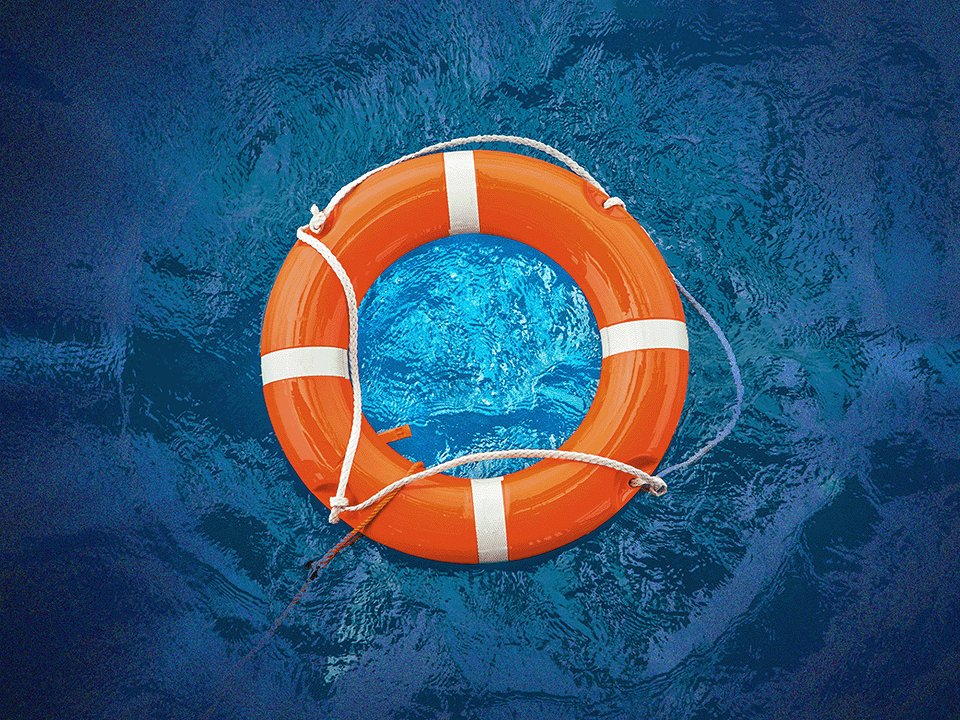6 Things We’re All Getting Wrong About Suicide
The more you know, the more you can help.
You’re forgiven if, up until now, you assumed that someone who’s having suicidal thoughts needs to be hospitalized ASAP (that’s rare!). Ditto if you think that having honest conversations about this topic increases the risk of suicide (it doesn't!). Those myths about suicide and others have been floating around for basically ever, but when they go unchecked, it can hurt the people who need help most.
People dealing with suicidal thoughts can start to internalize or believe these kinds of narratives. They might feel judged or ashamed, which can ultimately hold them back from getting help. “[These suicide myths] make it feel like [suicidal ideation] has to be this big secret, which deters people from seeking help or acknowledging that they're struggling,” says therapist Whitcomb Terpening, LCSW-S, founder of The Semicolon Group, an outpatient mental health practice that works with those who have experiences with suicide. Likewise, misconceptions can keep others from checking in on someone they might think is struggling with suicidal thoughts.
Whether you’re dealing with suicidal ideation or know someone who might be, those myths about suicide can make discussing mental health symptoms like this especially scary, Terpening adds. But the fact that you’re here means you’re probably game for breaking that stigma, and we’re happy you made it.
Once you're armed with these facts, you’ll be more prepared to find some support or assist someone who needs it. And, to my fellow know-it-alls, feel free to kindly correct anyone misspeaking about suicide by dropping this link.
1. Myth: You can trigger someone’s suicidal thoughts by asking about them.
If someone isn’t having suicidal thoughts in the first place, asking them about that possibility won’t make them have those thoughts, says Terpening. “They won’t, all of a sudden, be like, ‘I was perfectly fine, but now that you mentioned the word suicide, I guess I’ll go think about [actually killing myself],” she explains.
At worst, if someone isn’t thinking about killing themself, it’ll annoy, frustrate, or embarrass them when you ask them if they are, Terpening says. Maybe they had a bad day, and you took their “LOL I want to die” text literally. You’re not wrong for being a concerned friend/citizen/human!
And if someone is in fact having suicidal thoughts, talking about suicide with them won’t make things worse. When someone with suicidal ideation tells you about their thoughts, that can lessen the power those ideas had over them, Terpening explains.
Going to them directly also takes the pressure off of them to initiate this tough convo, Terpening notes. It gives them permission to share what they’re going through and lets them know that they have a safe person ready to listen, she says.
“So many times, suicide can be prevented by running toward a person struggling rather than running away,” stresses Jill Harkavy-Friedman, PhD, the senior vice president of research for the American Foundation for Suicide Prevention (AFSP). And, if you’re the one having a hard time right now, this conversation can help emphasize that you’re not alone, people will not be better off without you, and there are things you can do to feel better, she says.
2. Myth: Only people who have mental health conditions die by suicide.
Yes, mental health disorders have been linked to suicide. A 2018 CDC report suggests 46% of people who died by suicide had a known mental health condition. That said, not everyone who has suicidal thoughts or dies by suicide has a disorder.
Life circumstances like financial stress or divorce could also be behind someone’s suicidal ideation, says suicidologist and professor of social work at Loyola University Chicago Jonathan B. Singer, PhD, LCSW. Those situations, along with stuff like grief or health issues, can make people feel hopeless or like they’re a burden regardless of whether they have a diagnosable mental health issue.
Remembering that anyone at any time can experience suicidal ideation might inspire you to check in on a friend who seems to be going through it or feel more empowered to seek help for your own suicidal thoughts.
3. Myth: Self-harm is always a suicide attempt.
It might seem like somebody who hurts themself on purpose doesn’t want to live anymore. But it’s more often a way some cope with overwhelming emotions or feel something when they’re numb or dissociating, says Dr. Singer. Though, in his experience, people sometimes use self-harm as a way to actually deal with the pain of suicidal thoughts, that’s different than trying to act on those ideas, Dr. Singer notes.
That said, some research suggests that a long history of self-harm is associated with a higher risk of suicidal thoughts and behavior. “The more destructive the harm becomes, the more likely it is that you’ll also become somebody who thinks about killing themself,” Dr. Singer says. But self-harm and suicide attempts are not the same thing.
Still, if you find out that somebody close to you is self-harming, have a conversation with that person. You can say something like, “It sounds like you’re hurting. Can I do anything?” to let them know you get they’re in pain even if you don’t understand the reason, says Dr. Harkavy-Friedman. Then, you can offer to get them help, like setting up an appointment with a mental health pro or calling 988 if they’re having suicidal thoughts, she says.
4. Myth: Suicide is a white person problem.
While white men made up 69.68% of suicide deaths in the U.S. in 2021, according to the AFSP, they’re not the only ones who struggle with suicidal ideation.
In 2021, the CDC reported that American Indian and Alaska Native people overall had the highest suicide rates. Plus, suicide rates have been on the rise in racially minoritized populations, assistant professor at the University of North Carolina at Charlotte Sonyia C. Richardson, PhD, LCSW, previously told Wondermind.
Thinking that suicide only impacts one race “implicitly and explicitly blocks people and programs from funding scholarships, programs, and interventions that can be used to support people who aren’t white [and are dealing with suicidality],” Dr. Singer says.
“People say, ‘This just doesn't happen to ___ people.’ Like, ‘It doesn't happen to Black people. It doesn't happen to Latinos, Native people. It doesn't happen to women…’ Suicide does not discriminate,” Dr. Richardson said.
5. Myth: People who die by suicide are selfish.
It’s totally valid to feel hurt if a loved one dies by suicide. But, a lot of the time, people who end their lives feel like their existence is a burden to others and sticking around would actually be selfish, says Dr. Singer. People who believe otherwise are not taking someone’s struggles seriously and aren’t trying to understand the painful experience somebody had when alive, he says.
That idea also puts the onus on the person who died by suicide, Dr. Singer says. But you wouldn’t blame someone for dying in a tornado, right? Unfortunately, people think that when the storm’s inside somebody, they suddenly have a choice, psychotherapist and suicidologist Stacey Freedenthal, PhD, LCSW, wrote in a powerful blog post in 2015. “The mind is deceptive. What appears to be a choice often is not truly a choice. … Nobody chooses to experience so much pain, loss, trauma, or mental illness that they feel compelled to die by suicide.”
6. Myth: Thinking about dying is always an emergency.
In 2021, 12.3 million adults in the U.S. seriously thought about suicide, 3.5 million made an actual plan, and 1.7 million attempted to take their own lives, according to a national survey from the Substance Abuse and Mental Health Services Administration (SAMHSA). Over a million attempts is still a heartbreaking stat, but it’s clear that not everyone acts on their suicidal thoughts. “Having suicidal thoughts alone is always a cause for concern, but having them doesn’t mean that someone is planning to attempt suicide [which is an emergency],” says Terpening.
Because suicidal ideation exists on a spectrum from thinking about dying by suicide (passive suicidal ideation) to planning an attempt (active suicidal ideation), not everyone who has suicidal thoughts needs to seek emergency care to prevent hurting themselves or others. “You can have thoughts of ending your life without the desire or the want or the intent to end your life,” says Dr. Singer.
So, you should obviously take your own thoughts or someone’s comments about not wanting to live seriously, but you don’t need to call 911 or head to the hospital when it comes up.
Instead, figure out whether there’s an imminent risk, meaning a plan to act in the next 24 to 48 hours. If that’s the case, and you or the other person is “unwilling or unable to delay suicide or work with others to [stay] safe,” then it constitutes an emergency, licensed clinical psychologist Ursula Whiteside, PhD, CEO of suicide prevention organization Now Matters Now, told Wondermind in a previous interview.
And while the idea of inpatient treatment and/or an emergency hold can feel really scary, these facilities keep people, like you or the people you care about, out of harm’s way until the crisis has passed.
If you aren’t sure, that’s OK. In that case, calling the Suicide & Crisis Lifeline at 988 will connect you with trained staff who can screen for the risk level and offer next steps, says Terpening. JFYI, here are more ways you can help someone with suicidal ideation.
Wondermind does not provide medical advice, diagnosis, or treatment. Any information published on this website or by this brand is not intended as a replacement for medical advice. Always consult a qualified health or mental health professional with any questions or concerns about your mental health.




